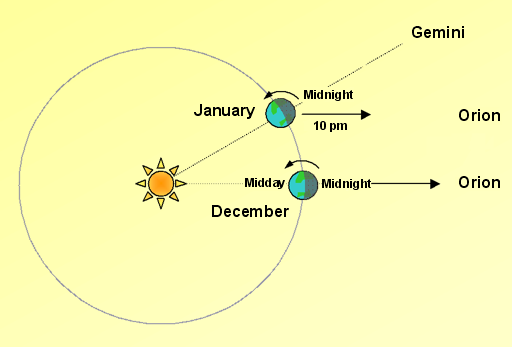2.4 Understanding how the sky changes with the seasons
In the previous activity, you looked at how the view of the sky changes during one night. This apparent motion of the sky is caused by the rotation of the Earth on its axis, once every 24 hours. As the Earth turns, you are looking in different directions out into space.
Now imagine a straight line drawn from the Sun through the Earth and extending out into space. Looking along this line out into space from the side of the Earth facing away from the Sun determines which part of the sky will be seen at midnight. As the Earth orbits around the Sun the direction of this line will change. This change is very gradual over one day, but in a month the direction changes significantly – by one-twelfth of a circle– and during the course of a whole year our view of the night sky will continue to shift, eventually coming back to the same view one year later – as was shown earlier.
You can use Stellarium to explore this seasonal change of the night sky.
Activity 5 Moving through the seasons
Open Stellarium and set the time as before to give a night-time view of the sky. Note the position of a prominent constellation.
- Now use the Date and time window to move forward first by one day at a time, and note what happens to your chosen constellation.
Next, use the Date and time window to move the view forward one month at a time. Note how the view changes month by month.
How many months does it take for the view to return to the position you first noted?
Answer
You should have noticed that it takes twelve months for the view to cycle round completely back to the original view. This is because the Earth has completed one full orbit around the Sun and returned to the position it started from, meaning that the view of space from the night-time side of the Earth is the same as it was one year earlier.
- Use the Date and time window to change the date by one month. Note how the view changes. Then go back to the original date and change the time forward or backward hour by hour within one evening.
Within one evening how many hours does it take for the view to change by the same amount as it does when changing the date by one month?
Answer
You should find that the view changes by the same amount in two hours of one evening as it does when changing the date by one month. This makes sense because it is one-twelfth of a complete rotation, just as one month is one-twelfth of a year. The Earth turns on its axis once every 24 hours, so in two hours it rotates through the same angle (30 degrees) as the Earth’s position in its orbit changes in one month.
To view larger versions of diagrams on the course click ‘View larger image’ located underneath the figure on the left-hand side.
In this activity, you have seen how the view of the night sky changes with the time of night and the time of year. In the next section, you will look at two systems of coordinates that can be used to map the sky and locate objects precisely.

